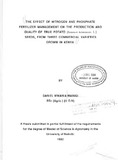| dc.description.abstract | Three experiments were conducted in the field to study the effect of fertilizer management on True potato (Sotanum tuberosum, L.) seed (TPS) production and quality. In the first experiment, the effects of split applications of Nitrogenous fertilizer (112.5 Kg N ha’1) on flowering, pollen quality, berry production and TPS quality, were studied. In Experiment II, the effect of time of nitrogenous fertilizer application of a single dose of
112.5 Kg ha’1 on flowering, pollen quality, berry production and TPS quality,, was studied. Experiment III. involved three commercial varieties. Kenya Dhamana. Anett and Kenya Baraka under four levels of the nitrogenous fertilizer (0. 100, 200 and 300 Kg N ha*1) and 3 levels (60. 120, 180 Kg ha’1) of a phosphate (P2O5) fertilizer in factorial combination. The parameters studied in Experiment III were, flowering, pollen viability, berry and tuber yields.
In experiment I, additional split applications of N at hilling-up, and at flowering, gave a significantly higher mean flower number, pollen quality and berry yields. The treatments also had the highest mean number of TPS in 1000, in the large seed fraction. Tuber yields improved significantly, when N was split applied at planting and 30 days later at hilling-up.
In experiment II, application of N at hilling-up resulted in a significantly higher flower number, pollen viability, berry yields and TPS quality. However, application of the N fertilizer at the onset of flowering (50 days after planting) resulted in a significantly greater number of TPS in 1000. being in the larger seed Fraction (LSF). Both applications of N at hilling up and at flowering (30 and 50 days after planting) resulted in higher total
tuber yields, compared to application of N at planting or at berry development (75 days after planting).
In experiment III, outstanding varietal differences among the three commercial varieties were noted in almost all parameters studied, except mean tuber yields. Kenya Dhamana had outstanding performance in flowering, pollen quality and Berry production. Anett and Kenya Baraka were not significantly different from one another with regard to these TPS production parameters.
Variety and phosphate fertilizer interactions were significant. The general trend across all varieties was a decrease in flower numbers, pollen viability and berry yields.
Variety and nitrogen fertilizer interaction was significant across all varieties in pollen viability. The varieties showed a good response in pollen quality with the application of N. The general trend was increased viability at higher levels of N application.
Only the factor Nitrogen fertilizer levels showed significance in total tuber yield response. Kenya Dhamana showed highest yields at 300 Kg N ha'1, and at 200 Kg N ha'1 level for Anett and Kenya Baraka.
Low levels (i.e < 180 Kg P2O5) combined with high levels of N may be useful in TPS production at Kabete.
Considerable seasonal differences which resulted in almost a total lack of flowering in the varieties Kenya Baraka and Anett. | en_US |



